Iberis (Iberis) has a large number of parallel names: the pepper, the wall, the swap, Zlatocevet and Iberiek. Flower Iberis is an herbaceous plant, which refers to the family of cruciferous. The representative of Flora takes the origin from the regions of Spain. "Iberia" is an ancient name of the shore of Domanov, who covered Catalonia and Seville. The pepper has a fragrant aroma, which is very pleasant to the human nuchi. A universal plant - the leakage is often used in the field of medical recipes and has a high level of efficiency.
The Spanish flower grows in the mountainous regions of Malaya Asia, the Caucasus of the southern provinces of the European continent, the Mediterranean and the skirt. The odorless representative of the flora has two short and long petals. It is for this reason that the plant bears such a name as the "discharge". Flowers have a small caliber (up to 1 cm) and form the inflorescences of white, crimson and pink color. A part of the spacious escape system practically closes the whole green foliage and pleases the human gaze for 2 months (May-August).
Scientists in the sphere of botany firmly believe that the duration of flowering annual varieties is much higher than the corresponding indicator of perennials. The plant is short and reaches a height of up to 40 cm. The stems have a ribbed form and are elongated with wedge-shaped sheets. An extended escape can be raised or straight-resistant.
A large number of dacms use a very simple, but very cunning way to extend flowering. Experts recommend cutting 1/3 with switched flowers. Thus, the plant will be able to release new shoots on a damaged place. The flowering process is gradually transformed into fruit with small seeds. The final ovary of the flower has a round, elongated shape, which is flattened around and divided inside a narrow type partition. The plant has a rod type of root system and therefore does not like transplants.
Iberis. Plant reproduction
The reproduction of the crutches can be carried out both by seeds and cherenkov (division of the bush) in the way. Consider all options in more detail.
Fundamental rules
Zlatocevet is not particularly demanding for cultivation in garden sites and country beds. The gardener will need only carefully to adhere to a small number of simple rules. Consider this list:
- Competent selection of a place that is perfect for planting a flower. The pepper is a lover of the bright sun. Therefore, the place in the country area should take the rays of the heavenly shining. Otherwise, the mass death of plants in the near future will occur.
- Soil composition. Stagnation of moisture for this representative of the Flora is a negative factor. Thus, the owner should worry about creating a complex (draned) layer of sandy + sublibious soils. This recommendation will make a deposit for healthy growth and flowering of the entire plant.
- Think over the optimal irrigation system. Watering should be abundant, but rare. The best period for reclamation activities is the arid period in summer days.
- Produce high-quality flower feeding. This agronomical operation is not mandatory. But if you make comprehensive fertilizers, then Zlatocevet thanks to its owner with luxurious and fragile bouquets.
An interesting feature of Iberia is that its flowers in clear and sunny weather are fully opened, and in cloudy - buds are closed. Zlatocellov landing by mass groups will allow cross-pollination. Thus, hybrids with original colors can be obtained. The basis of the biological basis of the plant is a comprehensive instinct. It should be remembered when the formation of a bed. After all, all free space can be easily filled with Iberis.
Iberis, growing ever
In most cases, planting material is seen in special seaside containers, which are filled with high-quality substrate. From above the soil is recommended to sprinkle with sand. It is important to check the thickness of the earth over the seeds. This indicator should be no more than 1 centimeter.
An important stage is the creation of a greenhouse effect. To do this, you will need to cover the capacity with a transparent glass or durable film. The process of flushing seeds from the soil can be avoided if producing watering by spraying the liquid into small droplets. The seedling plant is made with a capacity.
Landing the seed material Iberis in open ground
- The seeds of Iberis are sown to the ground to the depth of up to 8 cm. The very first plant sprouts can be seen on the 7th day. Sowing it is necessary to carefully dispel at the rate of 20 cm between the sprouts, which will give the inflorescence of greater volume and flowery.
- A rather important nuance is the following rule. When sowing the walls of annuals with a weekly or two-week break, you can achieve an increase in flowering time. The shilling process is made by cutting the trunk of the plant of last year's age on the elements of 8 to 10 cm long. These pieces are planted in a half-day, and after a certain time - to the regular place of stay. Zalekov landing occurs at the end of the summer season (the last decade of August of the month), and the planned transplant - the spring of the next year.
- The division of iberius on small bushes is strictly in the spring period. The shoots should be shortened by 1/3, which is associated with the poor development of the flower. A reliable basis for the development of the crutzet (including individual stems) is the preparation of drainage land.
Seeding seeds in open soil is preferably carried out in late April - early May. There is also an option to plant a flower in front of the winter. For this, Iberis seed seed in front of the frosts in the second half of November. This agronomic reception minimizes the risk of cruciferous fleece. Many dackets simply leave old flowers on the beds, which will give selflessness. Young flowers on shooting can be careful to proper and moisturize.
Iberis, home care
In order to obtain seedlings, experienced gardeners at home seed seeds at the end of the winter period. In the head, it is always necessary to keep the idea that the flower negatively belongs to the transplant. Therefore, the Iberian landing in open ground is the most responsible period.
- Zlatocevet has a rather sensitive root system. The flower can be significantly sick if the skew damage will be even minimal. A transshipment method of transplant is the most rational option for this plant. An alternative can be played together with a capacity, which has cut bottom.
- Warm spring months are perfectly suitable for placing flowers into the soil. For the northern latitudes, May Month is ideal for the southern - March. The most important thing is that sprouts are formed at the exit, which in a short period of time must grow. In this case, small frosts for the plant will not be terrible. Sunny plot, sand-sleeved ground will become a reliable "refuge" for a fragrant flower.
Equipment landing and further care of Iberism
First of all, the soil should be treated with a special fungicidal solution. Such an agrochemical event at a high level eliminates the process of infection with fungal type diseases. It is quite important to stick to the interval between plants at 20 cm. This will create optimal conditions for the development of a seedling. The plant planting the plant ends with abundant irrigation and sealing the earth around it. The following land aelic measures are made under the condition of complete flower adaptation. The key rules for the care of Iberica can be considered:
- Watering should be made only with dry weather.
- It is allowed to carry out a fantastic plant no more than 2 times per season of mineral type fertilizers. 1st feeding - the appearance of the first sheets. The 2nd feeder is the time of bootonization of the plant.
- The trimming of the tagged buds and shoots should occur on 1/3 of the entire length.
- Varieties Perennials need a transplant every 4 years. Otherwise, the flowers will be small, the decorative type of plant will be lost.
Protection of Iberis from diseases and pests
The discharge fester is distinguished by persistent immunity in relation to pests and diseases of different types. But sometimes ailments can take the top over a weakened plant. Consider the most common diseases:
- Cruciferous (cabbage) Kila. The causative agent of this disease is a fungus, which has a property to exist in the soil up to 14 years. The parasitic form generates generic formation on the roots of the flower. Such pathologies can turn dynamically into malignant tumors that completely slow down the growth process. This disease is quite problematic to detect at the initial stages of the flow. Iberis leaves acquire a pale green (yellowish) shade and faded during the daytime. However, at night they are growing rapidly. It is worth noting that the cruciferous keel eliminates only young shoots. Adult representatives of the plant can live in a tandem with fungus for a long time, but they will slowly develop, and have an infallible inflorescence. In agronomy, this disease is considered incurable. The main measure of the struggle is the conduct of preventive measures: processing of seeds and confined material with appropriate drugs (including copper chlorofunction).
- Rizoktoniz. Cold and rainy spring is the most dangerous time of the year for the nearest. On the root and root areas of the stem, glossy stains of gray shade are formed. Quite often, this color is accompanied by the appearance of ferrous spots with clear splashes. Iberis Plant slowly swept and, as a rule, dies. Effective measures of confrontation with this ailment is the introduction of lime to the soil with an acidic environment + fertilizer. The set of measures includes the disinfection of soil with special fungicides + total destruction of infected plants.
- Cherver Muffer (Switching shaggy) is quite noticeable insects of the sucking type. They actively use the juice of the plant itself and distinguish a decent amount of sticky substance (Dew Media). This substance is an excellent site for the vital activity of a sage type mushrooms. The most interesting thing is that the plant in the insect activity does not lose its decorative properties. In the case of a timely detection of the parasite, it is necessary to carefully remove it from the flowers of Iberis and treat the sections with garlic tincture or concentrated solution from the soap. When the degree of lesion is large, it is necessary to carry out full-fledged chemical treatment with drugs. There is such an event 2 times with an interval of 2 weeks.
- Bell cabbage It is an parasitic insect of small sizes. A malignant microorganism attacks colonies and dynamically sucks all the liquid from the plant, thereby killing it. Leaves acquire white spots. For 7 days, the shoots are completely twisted and dry out, it comes to a complete stopping of the bootonization process. An efficient and reliable means of struggle is the use of tobacco beam and chemicals (sulfate-anabazine).
- Earth flea It is a lusted type beetle that dwells on the plant and massively devouring his green parts. The inner side of the leaves has uneven edges, the stems have loose "tracks", the flower gradually fades. The insect quickly moves due to rapid jumps. This insect loves young seedlings very much. Therefore, the gardener should systematically attend shoots and timely processing if necessary. For this purpose, a concentrated decoction of Pijmas and high-quality insecticides is applied. The effective option remains regular soil moistening in the area of \u200b\u200bsmall colors.
Methodology for collecting seeds Iberis
At the end of the bloom, annual vectors of the wall are completely removed from the soil along with the root. Perennial flowers will be partially cut. But how exactly to collect the desired plants seeds? This process is not much difficult.
- When the inflorescence fully fades, the precious fruits are neatly cut off and move into a warm room.
- In a dry place, the process of ripening will occur. At the same time, it is necessary to ensure that the straight sunlights do not fall on the seeds of the parcel. After all, the sown sowing material is absolutely unfit. For this box, the seeds are regularly twisted for uniform drying.
There is a simple alternative.
- Torn annual bush + cut shoots (perennial) are suspended on a rope in a dry room.
- Seeds should reach physiological maturity in about 18 days.
- Plants are lined with one-piece fabric or paper, which will be accumulated seeds (bursting ripe pods).
- Some gardeners simply leave the plant in the garden, where the flower is planted alone.
- The downside is randomly distributed seedlings throughout the site.
- The seeds should be stored in the paper, fabric bags, which are located in a dry and safe place.
Iberis - photo. Species and varieties
Botany allocates more than 40 kinds of raznolepestnika: annual, biennial and perennial. Consider the most popular varieties of Iberis /
Iberis umbrella
Iberis umbrella (Iberis umbellata) can reach 40 centimeters in height. The plant differs from the base branched stems. Strong-smelling flowers have varied color and bloom after 3 months after sowing the soil. Vital functions of the flowers up to 2 months. Planting and care of these plants is common, as in other species.
Iberis pink dream
Iberis pink dream (Pink Dream) is pyshnotsvetuschim and fragrant variety, which has bright colors. The plant is capable of withstanding temperatures down to 4 degrees. Flowering starts after 50 days and after the landing.
Iberis "Iceberg"
The highlight zawadzkii "Iceberg" in favor of his persistent and delicate flavor. Flowers of white color are excellent bee plant. The bush has a sprawling shape and reaches parameters of 35 cm. The plant begins to bloom in late May, and holds the beautiful inflorescences to 70 and days. Raznolepestnik likes to stay in the sun, reproduces mainly by seed. This variety is perfect for growing before winter. 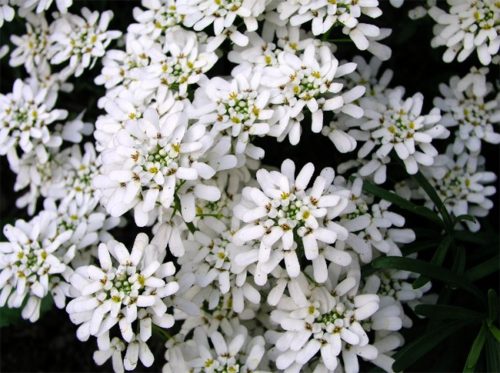
Iberis Rock
Rock Iberis (Iberis saxatilis) is a shrub creeping type which can reach a length of 15 cm Peduncle plant has a whitish color, sometimes -. Pink. Zawadzkii only seed material multiplies. The variety is not frost resistant and requires systematic shelter for the winter. 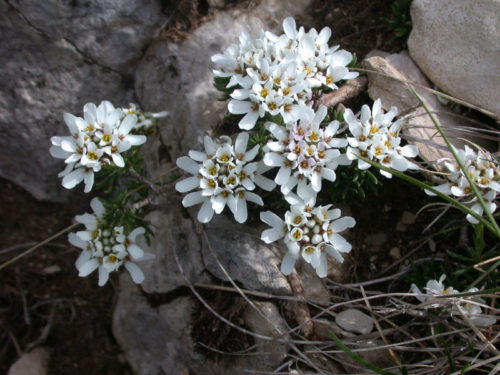
Iberis long
Iberis evergreen (Iberis sempervirens) -. Is a shrub, which reaches 30-40 cm in size sheet has a bright, saturated color green shade with smooth edges glossy color. Flower stalks have white color and keep up to 30 days.
Iberis Crimean
Crimean Iberis (Iberis Simplex or Iberis Taurica) is a dwarf view that reaches a maximum height of 10 cm. Its buds have a purple color, and the formed flowers are white. Leafs have a spatiary of a form of a boring green color.
The functionality of the grass of Iberian multifaceted. The plant looks quite beautifully in group landings and individually in the garden plot. The flower perfectly complements the lines of the border, tracks, alpine slides and near the nearby territory. The poles can be boldly to grow on the balcony and produce healing infusions for all occasions.



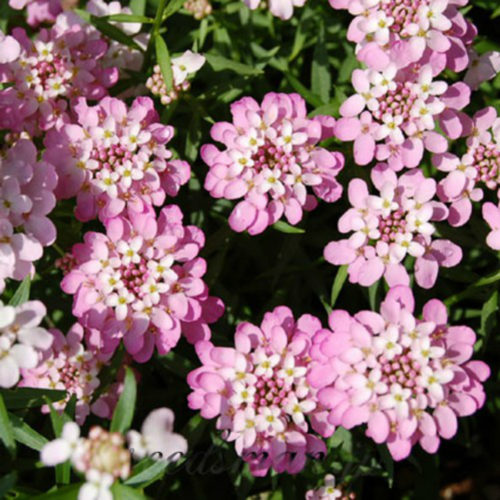
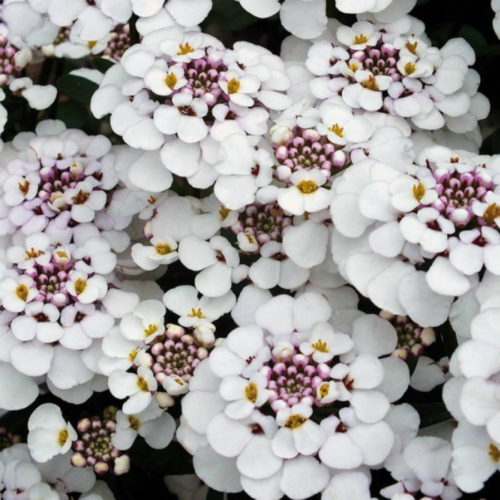

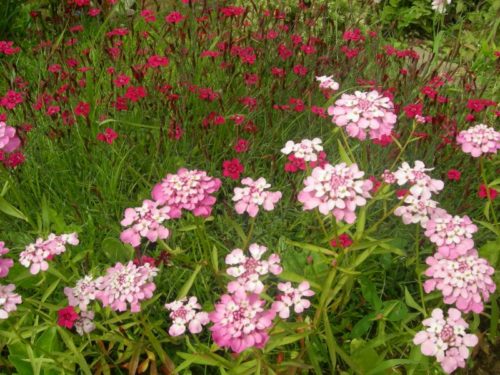
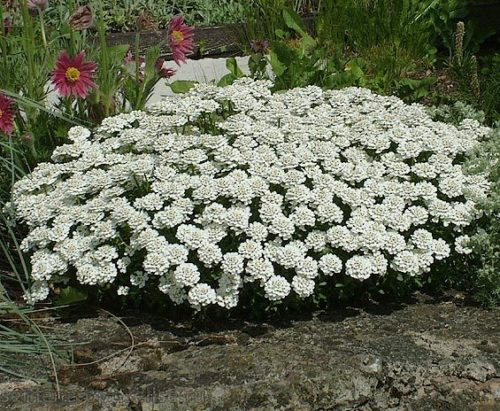
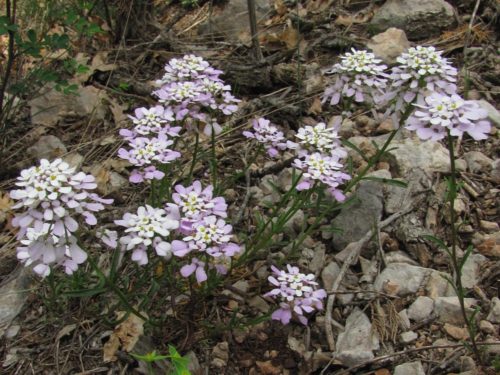












 Start a discussion ...
Start a discussion ...